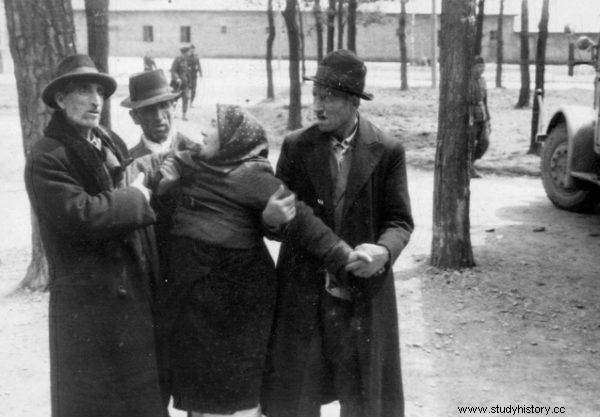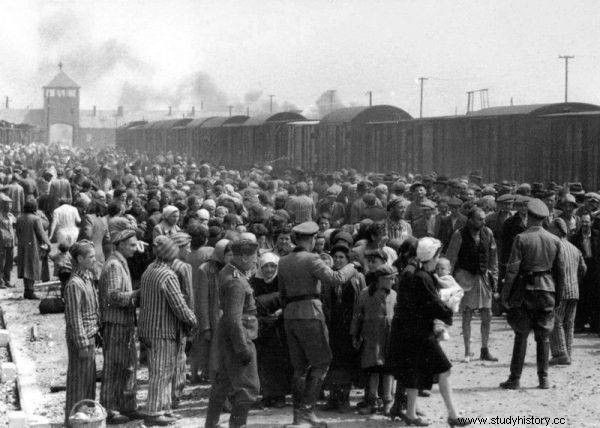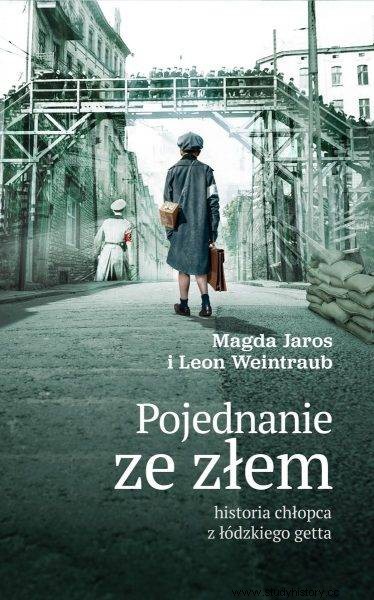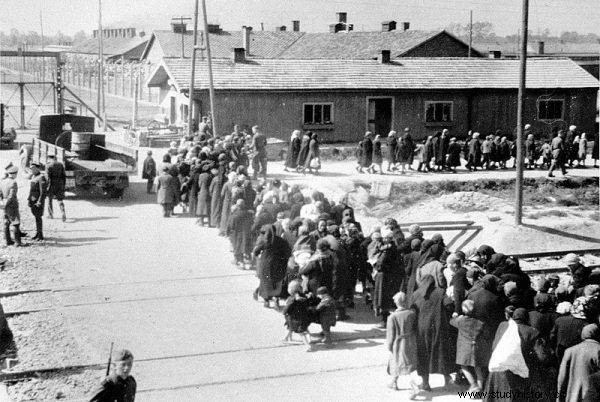Before we were rushed forward, I waved my hand, "Mom, I'll see you inside." I saw her for the last time on the ramp. Among the officers in black SS uniforms who made the selections was this horrible "doctor" Mengele. He leaned over Mom. I think there would be a possibility that a mother with three daughters in Auschwitz-Birkenau would have survived. It didn't.
At the Auschwitz-Birkenau museum in Oświęcim, we meet in October 2019 - the anniversary year. She is 75 years old since the liquidation of the Litzmannstadt ghetto and the last transport that left the Radegast station towards the camp.
Leon is flying in from Stockholm for three days. Especially for scouts who came with a school trip from Łódź. He also has an interview for Bavarian television and another ... Busy, on the run. He finds time to come with me to Brzezinka to the site of the former camp. There is not much left of the death factory:the headquarters buildings, a few barracks, the ruins of the crematoria. But there are tracks and a ramp where the selection took place. We stop next to a cattle wagon. Leon says that this is exactly how he was transported from Litzmannstadt.
A way to save a life
During the visit we are accompanied by doctor Maria Martyniak from the museum. Weintraub tells that he was placed in the former Gypsy camp in barracks 10. There is no trace of him. On the left, looking towards today's memorial, he could see the crematoria chimneys, on the right was the women's camp.
We reach one of the few remaining barracks and Leon enters it for the first time since September 1944. He watches the bunks intently, and I see him changing:his face freezes, you can see terror on it, he crouches inside himself, as if he wanted to become even smaller despite his short height. Does the body's memory echo in it? His way of saving his life was to become invisible, shrink, not draw attention to himself.

There is not much left of the factory of death:the headquarters buildings, a few barracks, the ruins of the crematoria. But there are tracks and a ramp where the selection took place.
Maria Martyniak shows us around the sanitary barrack. Leon does not remember that it only opened before morning and evening roll-calls. There was a water trough in it, where you could wet your hands and refresh your face. The prisoners did not have a towel or soap. Disgusting latrines were also prepared for the prisoners. Outside of the designated hours of access to the toilets, there were no pails for faeces in the residential barracks at the exit at the back that they could use at night. Surprisingly, he doesn't remember much of the few weeks he spent in Birkenau.
We both live at the Center for Dialogue and Prayer in Oświęcim. The next day, we sit down at a table in the lobby and turn on the recorder. Every now and then someone interrupts us, approaches us, asks if Leon was a prisoner, and when he hears an affirmative answer, he shakes his hands and takes a photo. Weintraub is cordial, although I can see that it costs him a lot to exchange courtesies. When we manage to find a quiet place, she apologizes, but there won't be much from today's interview. The visit to the barracks shocked him. Memories that his rational brain had dealt with a long time ago were revived.
"You don't come here to live"
Your first death factory painting from August 1944?
There were screams on the ramp:women to the right, men to the left, and forward, forward. Run. There are some strange figures around, as if in pajamas, with gray, blue and white stripes. I had a backpack on my shoulders, someone is tearing it away from me. I shout:"But I have stamps there!". Collecting them was my passion, just like cinema and books, so I took the stampers with me. And I can see a long face leaning over me, pale eyes and a voice:"You don't come here to live."
I wasn't aware of the deception yet, so my first reaction was, “What is he saying, we are supposed to start a new job, in a new place. What does he say you can't live here? ” But suddenly, as we run, I can see poles and barbed wires out of the corner of my eye. Besides, white porcelain insulators. I worked as an electrician in the ghetto, it became obvious to me that the wires were electrocuted. Barbed wire and electric fence ?! Where did I land?

Jews on the selection ramp
It was another shock that made me shut like a seashell. There is a concept of catatonia in medicine - a person hears, sees, feels, but his higher brain function is turned off, he hardly thinks. I fell into a similar state after arriving at the camp. It was a self-defense response. If we consciously grasp what has been done to us, the person would not be able to endure mentally.
On the ramp, I saw the thumb of an SS man who was directing:life to the right, i.e. able to work, death to the left. I was petite, but slim and upright. I saw a thumb to the right.
Human reflexes
What happened to mom and sisters?
Before we were rushed forward, I waved my hand, "Mom, I'll see you inside." Because I believed there had to be something inside. I can see her before my eyes:white blouse, navy blue suit, she still had some pink on her cheeks. She looked young at fifty-four. I saw her for the last time on the ramp. After the war my sisters told me that among the officers in black SS uniforms who made the selection there was this terrible "doctor" Mengele. He leaned over my mother, she was my height, a bit round, very nice, warm, with a nice smile.
I've never heard a sharp word from her lips. Mom said something, probably in German, and he waved his thumb to the right. I think there would be a possibility, a certain chance, that a mother with three daughters in Auschwitz-Birkenau would have survived. It did not happen. Ciocia Ewa, the one with whom we lived in the ghetto, was directed to the left, and she clung to her sister's hand. Mom followed her and on the same day they both ended up in the gas chamber. They were murdered.

The text is an excerpt from the book by Leon Weintraub and Magda Jaros, "Reconciliation with evil", which has just been published by Bellona. Buy now
My three sisters, after a short stay in Auschwitz-Birkenau, were selected to work. They landed in Mühlhausen, in a weapons factory. There were foremen overseeing the production of two Volksdeutsche. They spoke Polish. Lola, although without hair, in a modest dress, was a beautiful girl. I have photos of her from September 1945 from Bergen-Belsen. The Volksdeutsche had human impulses, they shoved their food over them. They worked hard but had beds and conditions incomparably better than what I had to live in.Dehumanization
You were alone in middle of hell.
After the selection - that was a new word for me - we were led to one of the buildings. It was strange, oblong, with a chimney at both ends. Beams were attached to the walls, rings were placed every two meters - as I later learned, these were former stables, and the rings were used to fasten horses.
In the middle, between the fireplaces with chimneys, there was a low brick wall, before the warm air flowed, which heated the barrack. A well-dressed and middle-aged man arrived. He walked both ways on the wall. He urged first with a gentle voice, then persuaded, finally threatened that if anyone hid golden dollars, coins, valuables or paper dollars wrapped in a condom in the openings of the body, and the X-ray detects it, he will be severely punished.
I remember the first reaction very clearly. Punished? And what is happening to us now is not a sufficient punishment? This was the first stage of what I call dehumanizing: admission of prisoners to the Auschwitz-Birkenau concentration camp.

Prisoners directed to the gas chambers
Then we were taken to the bathhouse, we had to hand over everything personal. The order could have been different, it is possible that the time of receiving the valuables was at the end. We took a quick shower. After him, a group of prisoners with hair clippers waited. There was a long line in front of everyone, but it was going fast. They shaved their heads, abdomen and armpits. Sometimes a piece of leather was torn out. The prisoners were still sitting there, and they had oily goo that reeked of phenol or carbolic acid. They dipped something like the mop you use to clean floors today and smeared it on the shaved areas. It was burning terribly, we were screaming in pain.
When leaving the building, other prisoners threw their clothes:jacket, shirt, pants, then pointed at the pile of clogs. I got pants that would fit two guys like me. Others do the same:the tall one hit too small pants. So the exchange began. Only after this process of dehumanization, depriving us of all human attributes and qualities, were we separated into the barracks.
As a young I was assigned - if I remember correctly - to Block 10 in Birkenau, which was on the site of the former Gypsy camp in the so-called Gypsy field. To make room for Jews from the Litzmannstadt ghetto, Germany in one night at the beginning On August, they murdered almost three thousand Roma.
The barrack was intended for four hundred prisoners, how many there actually were, it is not known. There were twenty-four bunks, each three stories high, each sleeping ten people. I remember that on the left side, looking from the exit, there were buildings with tall chimneys, from which, around the clock, day and night, pounded dark, heavy, thick smoke that reeked of burnt meat. On the right, behind the barbed wire, I saw women.
Source:
The text is an excerpt from the book by Leon Weintraub and Magda Jaros "Reconciliation with evil", which has just been published by Bellona.
